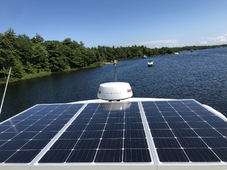svalvasori
New Member
I'm looking for opinions and pros/cons of different ways to improve my boats energy system. We are away from the dock for 3 nights most weekends in the summer and don't like to micro manage our power usage. The existing system has been working well for the past 7 years, however after adding Starlink, the balance was upset and we end up running the generator more than I would like, but we enjoy the connectivity so that's not going anywhere. We boat in northern Ontario where the sun insolation is 2.5-7.6 (5.1avg).
Some stats from last summer via Victron VRM historical data
Let me know your thoughts and any other details you need to make an informed call. Appreciate the input.
Steve.
Some stats from last summer via Victron VRM historical data
- Usage: 5-6 kWh per day
- Solar Production: 1.5-2 kWh per day
- Victron Multiplus 12/3000/120
- Victron CerboGX
- Victron SmartShunt
- Victron MPPT 12/45
- 660 W solar (3x 220W hard panels)
- 11 kW diesel generator
- 920 Ah lead acid house bank (8x GC 230Ah)
- Replace lead with 600 Ah lifepo4 and add 120A or so charge capability (closer to .5c). This increases my usable battery capacity and decreases my generator run time (Ideally 1 hr per day, which we would do anyway for hot water and/or to run the oven)
- Leave the lead acid batteries (they are only 1 season old) and add 500W of solar and controller.
Let me know your thoughts and any other details you need to make an informed call. Appreciate the input.
Steve.





